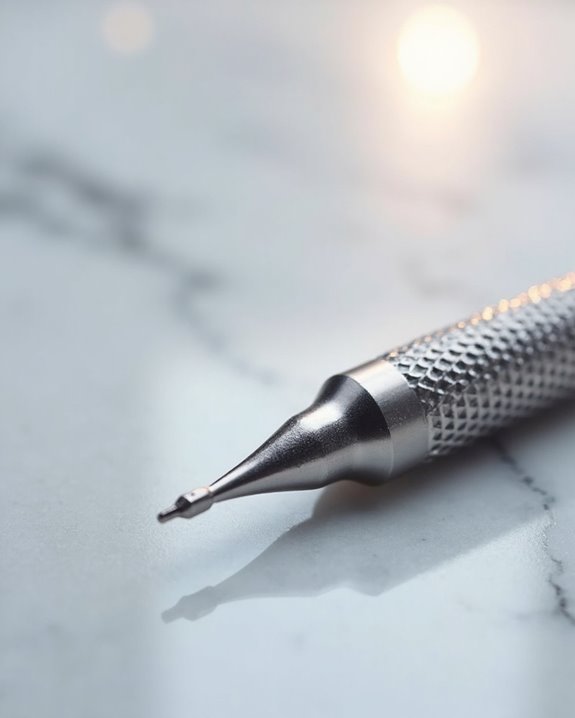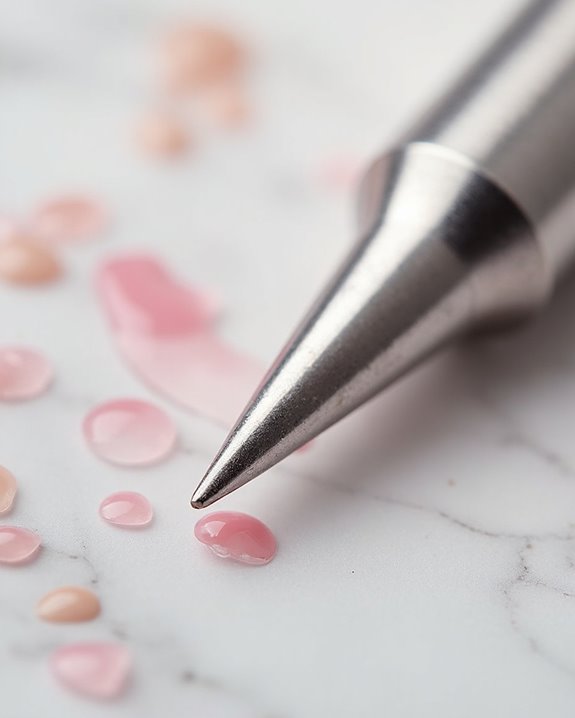Nail drill bits are specialized attachments for electric nail files that perform various manicure and pedicure tasks. These bits come in different materials (carbide, ceramic, diamond), shapes (barrel, cone, needle), and grit levels (coarse to fine), each designed for specific functions including acrylic removal, cuticle cleaning, nail shaping, and surface smoothing. The standard 3/32-inch shank fits most e-files, while bit selection should match the intended application, user skill level, and safety requirements. Proper understanding of each bit’s purpose guarantees the best nail care results.
Key Takeaways
- Nail drill bits are specialized attachments for e-files that perform functions like cleaning, shaping, smoothing, and removing nail products.
- Different bit materials (carbide, ceramic, diamond) offer varying benefits for durability, heat reduction, and specific nail applications.
- Common shapes include barrel bits for surface work, cone bits for cuticle prep, and needle bits for detailed work in tight spaces.
- Grit levels determine application—coarse (80-120) for product removal, medium (150-180) for general work, fine (180-240) for finishing touches.
- The standard shank size is 3/32 inches, with bits typically lasting 150-300 services when properly maintained with regular cleaning and disinfection.
Understanding the Basics of Nail Drill Bits
The fundamental components of nail drill bits serve as the cornerstone of professional nail enhancement services, enabling technicians to perform precise modifications on both artificial and natural nails. These specialized tools consist of an elongated shaft that inserts into the e-file handpiece and a working head available in different shapes, including barrel bits for surface work, cone bits for cuticle preparation, and needle shapes for accessing tight spaces. Nail drill bits come in various materials, with diamond bits ideal for exfoliation, carbide bits providing durability for enhancement removal, and ceramic options reducing heat during use. With a standard professional shank size of 3/32 inches, these acetone-proof tools facilitate multiple functions, from nail cleaning to precise shaping, typically lasting 150-300 services when properly maintained through regular bit cleaning. In addition, materials like tungsten carbide offer exceptional resistance to wear, corrosion, and high temperatures for reliable performance.
Types of Materials Used in Nail Drill Bits
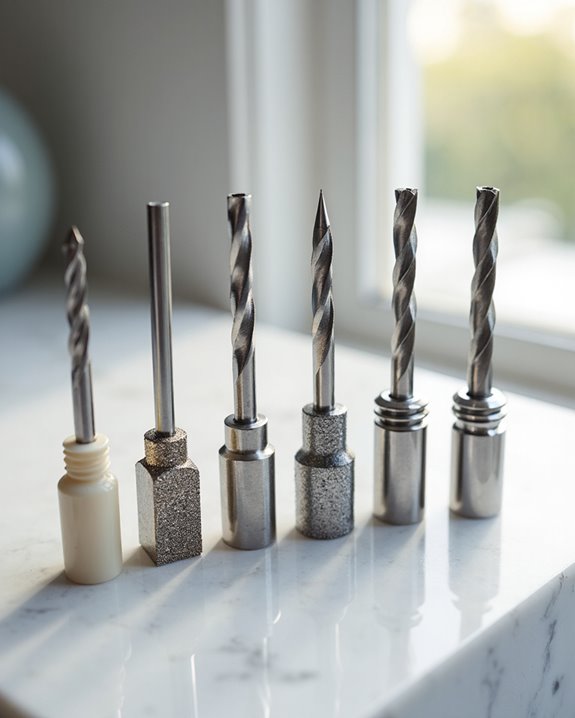
Various materials used in nail drill bits greatly impact their performance, durability, and suitability for specific nail enhancement applications. Carbide nail drill bits, including the popular Flame Carbide bit, are manufactured from durable carbide metal that withstands repeated use and excels at acrylic removal and shaping. Ceramic bits feature specialized fluted teeth with heat-reducing properties, making them ideal for precise product removal without excessive friction. Diamond bits contain actual embedded diamonds that provide aggressive abrasive action for effectively exfoliating products and skin. Mandrel bits, typically made of metal or rubber, serve as holders for detachable sanding bands of varying grits. These fabric sanding bands, available in fine to coarse textures, offer versatility for surface smoothing, gel polish removal, and pedicure treatments, complementing the mandrel bit’s functionality. Furthermore, diamond carbide bits reduce heat generation and provide precision for detailed work around cuticles and sidewalls.
Common Shapes and Their Specific Applications
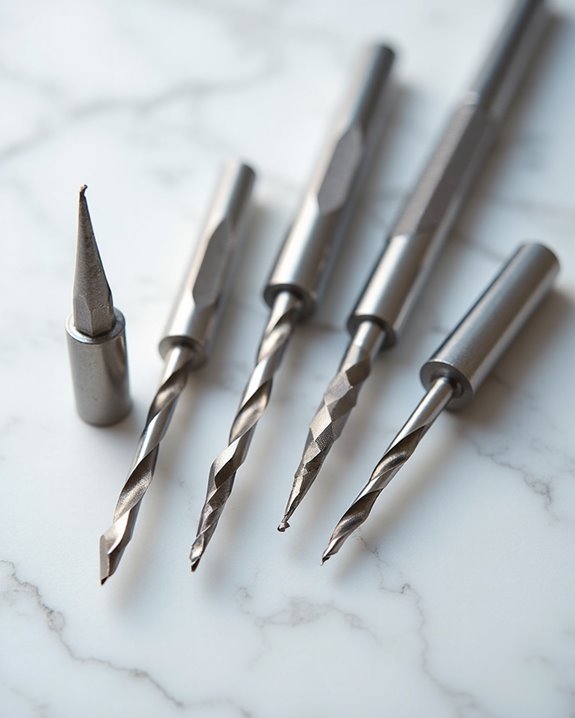
Nail drill bits come in a variety of specialized shapes, each designed for particular applications within nail enhancement procedures, allowing technicians to achieve precise results for different areas of the nail. Barrel bits excel at surface work, including shortening, shaping, and backfill cutting, but should never contact the cuticle area to prevent injury. Cone bits, with their tapered design, are ideal for cuticle area preparation, cleaning sidewalls, and working beneath nails, particularly for toenail shaping. Needle bits feature pointed tips for accessing tight spaces, enabling technicians to clean under nails and create decorative elements. Tapered barrel bits provide controlled removal for in-fill procedures and cuticle preparation, while the versatile 5-in-1 bit combines multiple functions to efficiently clean, prepare, shape, shorten, and smooth nails during manicure services. Furthermore, many of these bits are designed with 3/32-inch shanks for compatibility with a wide range of electric nail machines, ensuring seamless and safe operation.
Selecting the Right Grit Level for Your Task
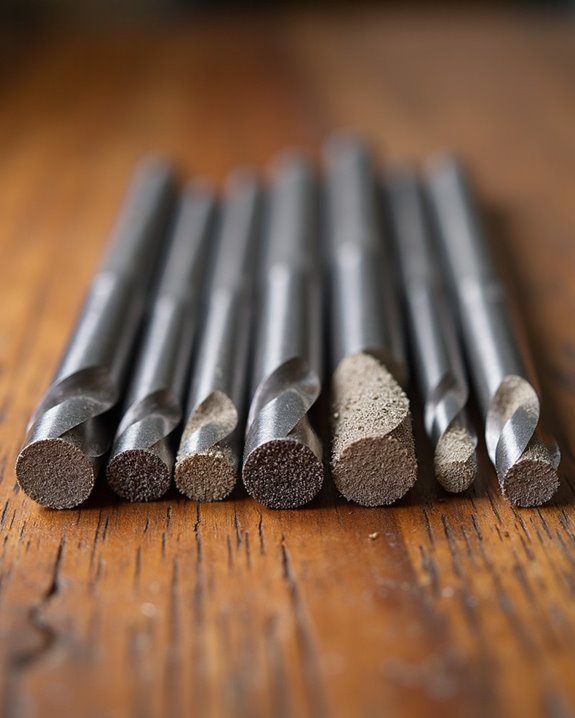
When selecting nail drill bits, understanding grit levels proves essential for achieving best results without damaging the natural nail or causing client discomfort. The level of grit directly impacts both efficiency and safety during nail services, with options ranging from coarse to fine textures.
Coarse bit selections (80-120 grit) excel at rapid removal of acrylics and dip powder, while medium grit bits (150-180) provide balanced control for backfills and lifted areas without damaging natural nails. Fine grit and fine texture bits (180-240) offer gentle smoothing capabilities ideal for natural nail preparation and finishing touches. For delicate cuticle work, technicians should select medium and coarse options sparingly, prioritizing fine grit for safety around sensitive areas. Choosing the right bit depends on both the specific task requirements and the technician’s experience level.
Best Practices for Using Nail Drill Bits Safely
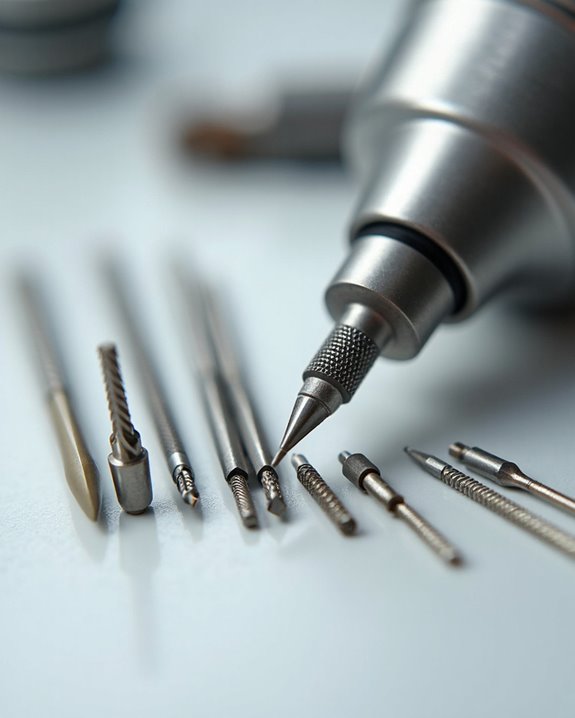
Prioritizing safety protocols when operating electric nail files guarantees both client comfort and professional longevity in nail services. Technicians should clean each bit thoroughly after use with a cleaning brush to remove debris before applying a liquid disinfectant, which prevents damage to both bits and subsequent clients’ natural nails. Medium-grit bits, such as the Smooth Top Medium, are highly recommended for beginners, while the Smooth Top Fine provides controlled filing without damaging natural nail plates.
Selecting the correct bit for the job remains essential to avoid lifting or tearing nail layers during service. Experts recommend resting the operating hand on a stable surface to maintain precision while working, particularly when using higher RPMs. Additionally, professionals should dispose of single-use sanding bands properly after each client, maintaining hygienic standards required in salon environments.
Maintenance and Cleaning for Long-Lasting Performance
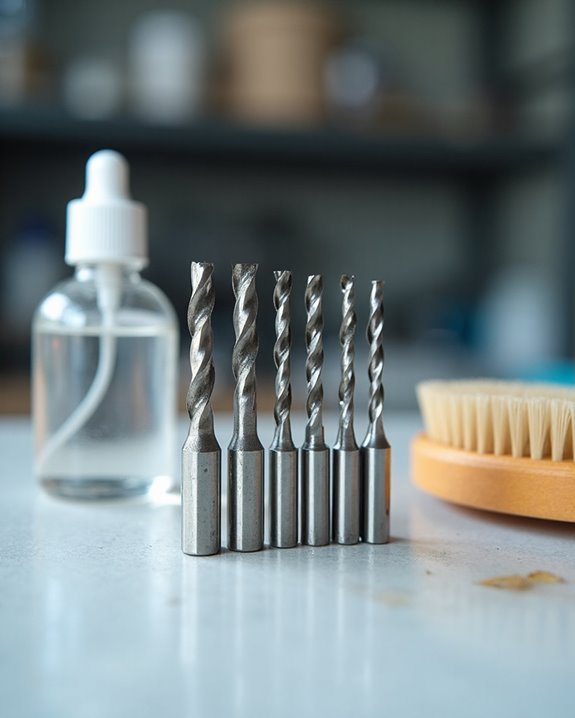
The longevity of professional nail equipment directly correlates with proper maintenance practices, extending beyond safety protocols into preservation techniques. High Quality nail drill bits are made to withstand regular use, but require systematic cleaning after each client service. Technicians should use a brush, soap, and warm water as the first step, perfect for cleaning without damaging your clients’ potential for infection transfer.
Materials of Nail Drill bits determine the appropriate cleaning methods: carbide and ceramic bits can be used with alcohol, though exposure should be limited to a minimal amount of time. While a cuticle cleaner brush removes surface debris, complete sanitation requires either acetone pre-soaking followed by disinfection, or thorough scrubbing. Remember that Nail Cleaner solutions must be followed by complete drying, while sanding bands cannot be reused and must be discarded after each service.
Professional vs. At-Home Nail Drill Bit Recommendations
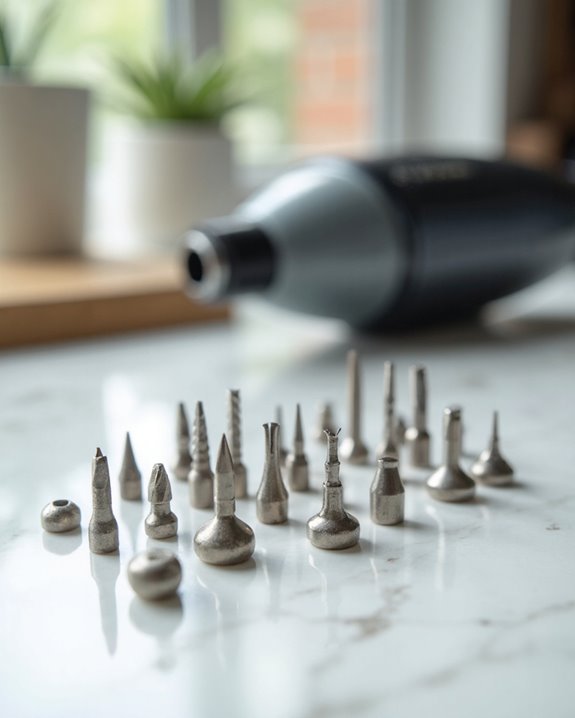
Selecting appropriate nail drill bits requires understanding the significant differences between professional salon requirements and at-home usage needs, particularly regarding durability, safety, and technique proficiency. Professional technicians typically invest in carbide bits, which withstand 150-300 services and efficiently remove acrylics, gels, and dip powders at high RPMs.
At-home users, meanwhile, should prioritize safety with medium to fine grit bits specifically designed to be used on natural nails. The Natural Nail Dry Mani Kit offers suitable options for beginners, featuring safety bits with rounded tops that protect cuticles and sidewalls. While professionals might select a Barrel Coarse bit for artificial nail removal, at-home enthusiasts should opt for gentler alternatives like the Barrel Fine or Polisher bit. Most electric nail files for home use accommodate standard 3/32″ shank sizes, ensuring compatibility with commonly available bits.
Frequently Asked Questions
What Are Different Nail Drill Bits For?
Different nail drill bits serve specialized functions in nail care. Barrel, needle, cone, safety, and 5-in-1 bits each address specific tasks requiring proper speed adjustment, technique practice, and safety gear when used with electric drills on natural nails.
What Are the Different Types of Drill Bits and What Are They Used For?
Like a toolbox for various projects, traditional drill bits include WoodBits, MetalDrills, MasonryTools, TwistBits, SpadeDrills, ForstnerTools, HoleSaws, StepDrills, CountersinkBits, and BradPoint—each designed for specific materials and hole-making applications.
What Do the Colors of Nail Drill Bits Mean?
Color codes on nail drill bits indicate functionality and material composition. Bit hues like purple denote specialized enhancements, while other tint legends differentiate abrasiveness levels, durability features, and intended applications in professional nail care.
What Is the Difference Between Diamond and Carbide Nail Drill Bits?
Like night and day, diamond and carbide bits differ greatly. Diamond bits offer hardness for exfoliation but lower heat tolerance, while carbide bits provide superior durability, edge retention, wear resistance, and precision accuracy for artificial nail removal.


